-

新人教版高中英语必修2Unit 2 Wildlife Protection-Reading for Writing教案二
This lesson aims at making a poster about protecting wildlife after reading some posters. During reading students are guided to understand the content and try to summarize the posters with one sentence. Then students are guided to try to make a poster about protecting wildlife.1. Read the two posters and try to understand the summary sentences.2. Look at the two posters and try to understand what emotions they express.3. Try to summarize the features of posters4. Try to make a poster about wildlife.1. Look at the two posters and try to understand what emotions they express.2. Try to summarize the features of posters3. Try to make a poster about wildlife.Step 1 Lead inLook at the the posters on the textbook and ask:Which emotions do the posters communicate ?Step 2 Read the poster and answer the questions.1. What do you think of the animals in the poster on the left ?I think it is frightening and ugly.2. Why do we should protect the ugly animals ?All species--the good, the bad, and the ugly-- should be treated equally.The world needs all kinds--without variety, our planet cannot survive.3. Why are billions of trees being cut down every year ?To make paper for humans.4. What result will be lead to after the trees are cut down ?A lost of animal homes are being destroyed./The habitat of wildlife is being destroyed.Step 3 Find the feature of posters1. What does each poster use to stir up emotions ?On the left, it makes us a little frightened and it looks a little ugly, but it can activate our curiosity--What is it? And What is wrong with it?On the right, it makes us feel a little sad and want to protect them.

新人教版高中英语必修2Unit 2 Wildlife Protection-Reading and Thinking教案二
The theme of this unit is human and nature, focusing on the theme of wildlife protection. Nature is a complex ecosystem, in which there are delicate balance between animals and plants. Because of the role of the food chain, the extinction of one species will produce influence, causing a series of chain reaction. Large scale extinction of species will have a serious and even irreversible impact on the ecosystem, resulting in immeasurable losses. Therefore, it is of great significance to protect wild species. To protect wild species is to protect human beings themselves. The motto of this unit is "when the buying stops, the killing can too,” which is a public service advertising slogan to protect wildlife. It tells people that every rhinoceros horn, every fur, every bowl of shark fin soup, every Ivory product, and every tiger bone product, etc. consumed by human beings, are innocent wild animals slaughtered behind them. The mission of wild aid is to ban illegal trade in endangered wildlife and mitigate climate change. It aims to educate the public to reduce the consumption demand for endangered wildlife products through public publicity and improve the awareness of environmental protection.1. Improve the awareness of wildlife protection by acquiring the knowledge of wildlife protection.2. Focus on environmental protection and protection of all lives.3. Analysis of the living environment of wild animals with appropriate thinking mode.4. Skillfully use the vocabulary and grammar knowledge of this unit to cultivate self-study ability according to the unit content5. Develop cooperative learning ability through discussion and other ways1. Enable the Ss to talk about the current situation of wild animals.2. Guide the Ss to summarize the main idea of each paragraph as well as the main idea of the text.
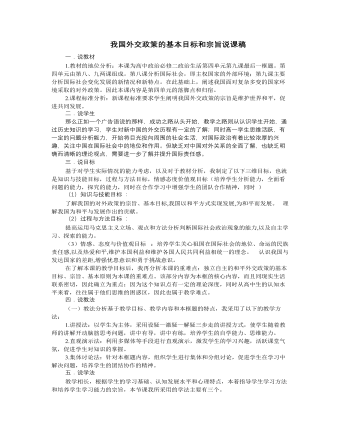
人教版高中政治必修2我国外交政策的基本目标和宗旨说课稿
环节四 课堂小结 巩固知识本节课我采用线索性的板书,整个知识结构一目了然,为了充分发挥学生在课堂的主体地位,我将课堂小结交由学生完成,请学生根据课堂学习的内容,结合我的板书设计来进行小结,以此来帮助教师在第一时间掌握学生学习信息的反馈,同时培养学生归纳分析能力、概括能力。环节五 情景回归,情感升华我的实习指导老师告诉过我们,政治这一门学科要从生活中来到生活去,所以在课堂的最后布置课外作业,以此培养学生对理论的实际运用能力,同时检验他们对知识的真正掌握情况,以此达到情感的升华,本节课,我根据建构主义理论,强调学生是学习的中心,学生是知识意义的主动建构者,是信息加工的主体,要强调学生在课堂中的参与性、以及探究性,不仅让他们懂得知识,更让他们相信知识,并且将知识融入到实践当中去,最终达到知、情、意、行的统一。
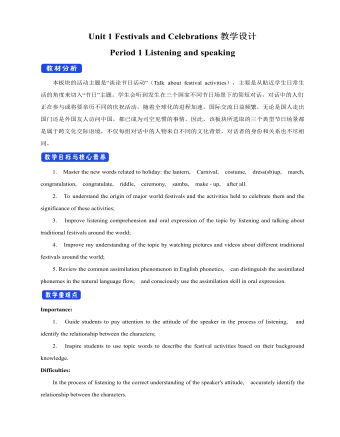
新人教版高中英语必修3Unit 1 Festivals and Celebrations教学设计一
本板块的活动主题是“谈论节日活动”(Talk about festival activities),主要是从贴近学生日常生活的角度来切入“节日”主题。学生会听到发生在三个国家不同节日场景下的简短对话,对话中的人们正在参与或将要亲历不同的庆祝活动。随着全球化的进程加速,国际交流日益频繁,无论是国人走出国门还是外国友人访问中国,都已成为司空见惯的事情。因此,该板块所选取的三个典型节日场景都是属于跨文化交际语境,不仅每组对话中的人物来自不同的文化背景,对话者的身份和关系也不尽相同。1. Master the new words related to holiday: the lantern, Carnival, costume, dress(sb)up, march, congratulation, congratulate, riddle, ceremony, samba, make - up, after all. 2. To understand the origin of major world festivals and the activities held to celebrate them and the significance of these activities;3. Improve listening comprehension and oral expression of the topic by listening and talking about traditional festivals around the world;4. Improve my understanding of the topic by watching pictures and videos about different traditional festivals around the world;5. Review the common assimilation phenomenon in English phonetics, can distinguish the assimilated phonemes in the natural language flow, and consciously use the assimilation skill in oral expression. Importance:1. Guide students to pay attention to the attitude of the speaker in the process of listening, and identify the relationship between the characters;2. Inspire students to use topic words to describe the festival activities based on their background knowledge. Difficulties:In the process of listening to the correct understanding of the speaker's attitude, accurately identify the relationship between the characters.
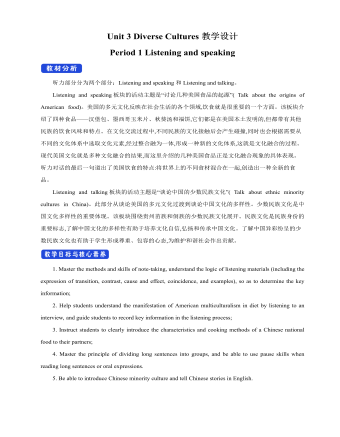
新人教版高中英语必修3Unit 3 Diverse Cultures教学设计一
Activity 81.Grasp the main idea of the listening.Listen to the tape and answer the following questions:Who are the two speakers in the listening? What is their relationship?What is the main idea of the first part of the listening? How about the second part?2.Complete the passage.Ask the students to quickly review the summaries of the two listening materials in activity 2. Then play the recording for the second time.Ask them to complete the passage and fill in the blanks.3.Play the recording again and ask the students to use the structure diagram to comb the information structure in the listening.(While listening, take notes. Capture key information quickly and accurately.)Step 8 Talking Activity 91.Focus on the listening text.Listen to the students and listen to the tape. Let them understand the attitudes of Wu Yue and Justin in the conversation.How does Wu Yue feel about Chinese minority cultures?What does Justin think of the Miao and Dong cultures?How do you know that?2.learn functional items that express concerns.Ask students to focus on the expressions listed in activity. 3.And try to analyze the meaning they convey, including praise (Super!).Agree (Exactly!)"(You're kidding.!)Tell me more about it. Tell me more about it.For example, "Yeah Sure." "Definitely!" "Certainly!" "No kidding!" "No wonder!" and so on.4.Ask the students to have conversations in small groups, acting as Jsim and his friends.Justin shares his travels in Guizhou with friends and his thoughts;Justin's friends should give appropriate feedback, express their interest in relevant information, and ask for information when necessary.In order to enrich the dialogue, teachers can expand and supplement the introduction of Miao, dong, Lusheng and Dong Dage.After the group practice, the teacher can choose several groups of students to show, and let the rest of the students listen carefully, after listening to the best performance of the group, and give at least two reasons.
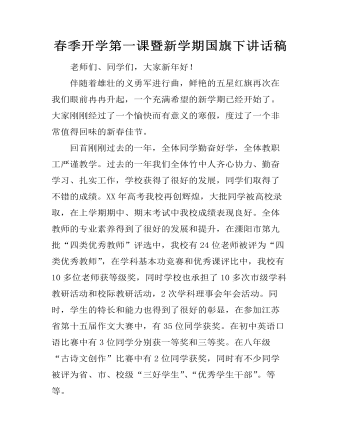
春季开学第一课暨新学期国旗下讲话稿
老师们、同学们,大家新年好!伴随着雄壮的义勇军进行曲,鲜艳的五星红旗再次在我们眼前冉冉升起,一个充满希望的新学期已经开始了。大家刚刚经过了一个愉快而有意义的寒假,度过了一个非常值得回味的新春佳节。回首刚刚过去的一年,全体同学勤奋好学,全体教职工严谨教学。过去的一年我们全体竹中人齐心协力、勤奋学习、扎实工作,学校获得了很好的发展,同学们取得了不错的成绩。XX年高考我校再创辉煌,大批同学被高校录取,在上学期期中、期末考试中我校成绩表现良好。全体教师的专业素养得到了很好的发展和提升,在溧阳市第九批“四类优秀教师”评选中,我校有24位老师被评为“四类优秀教师”,在学科基本功竞赛和优秀课评比中,我校有10多位老师获等级奖,同时学校也承担了10多次市级学科教研活动和校际教研活动,2次学科理事会年会活动。同时,学生的特长和能力也得到了很好的彰显,在参加江苏省第十五届作文大赛中,有35位同学获奖。在初中英语口语比赛中有3位同学分别获一等奖和三等奖。在八年级“古诗文创作”比赛中有2位同学获奖,同时有不少同学被评为省、市、校级“三好学生”、“优秀学生干部”。等等。
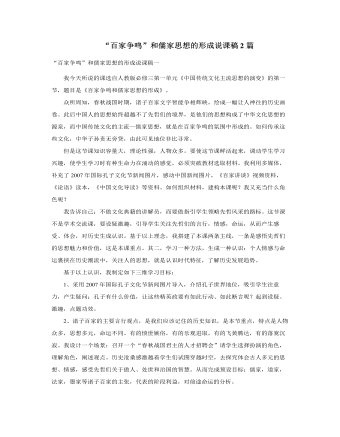
人教版高中历史必修3“百家争鸣”和儒家思想的形成说课稿2篇
我们知道事物之间的矛盾会发生转化。但是,由于老子看不到转化的条件,更看不到人的主观能动性,因此他对人类社会的发展抱着消极悲观的态度,幻想回到“鸡犬之声相闻,老死不相往来”的“小国寡民”的社会。他的思想,通过《老子》一书留传了下来。后来的庄子继承了老子的思想,把“道”作为世界最高的原则,我们可以来看发生在庄子身上的一个故事:庄子在妻子死后,居然鼓盆而歌,朋友惠施去探望时责备他,他讲出一番道理:“当我妻子刚死的时候,我怎么会不难过?可是我省思之后,觉察到她不但没有生命,而且没有形体;不但没有形体,也没有气,然后在恍恍惚惚的情况下,变出了气,气再变化而出现形体,形体再变化而出现生命,现在又变化而回到死亡,这就好像春夏秋冬四季的运行一样。这个人已经安静地睡在天地的大屋里,而我还跟在一旁哭哭啼啼。我以为这样是不明白生命的道理,所以才停止哭泣啊!”

人教版高中历史必修3充满魅力的书画和戏曲艺术说课稿2篇
师:很好!我们知道,元明清时期,我国封建社会进入衰落时期,封建专制不断加强,对文人的思想控制也在不断加强,士大夫文人只有通过画来表达自己的想法和内心世界,所以这时候的画强调借物抒情。大家可以再看到这幅清朝郑板桥《墨竹图》,竹子非常清新俊逸,抒发了一个清高的文人情怀。大家可以仔细品味,郑板桥的竹子有种脱俗的感觉,看后让人非常静心。同学们,在欣赏国画的时候,我们不是一味地去看它像不像,而要更多去体会他的精神与气质,没有思想与内涵的人是画不出一副好画的,就算他画技再好,他的也是没有灵魂的。中国的水墨画,虽然没有涂颜料,它却会使你感受到春天的绿,秋天的黄和冬天的白,我们可以在画中找寻到自己精神的共鸣。好,刚刚讲了这么多,现在请一位同学看到这表格来归纳一下每个时期国画的不同特点。
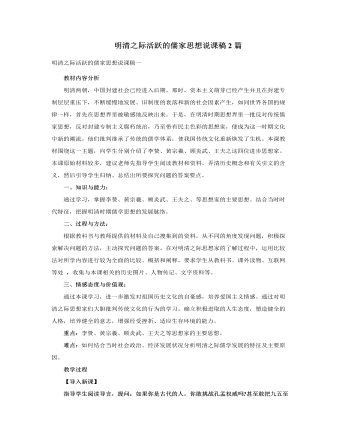
人教版高中历史必修3明清之际活跃的儒家思想说课稿2篇
这是略带提高性的问题,旨在提高学生认识历史的能力,搞清这一历史问题有助于理解中西历史发展的不同。(学生讨论,教师总结归纳并展示。)不是资产阶级民主思想,因为它们是资本主义萌芽的产物,资产阶级作为一个阶级还没有产生。中国民主思想只停留在批判的层次上,并没有提出新的思想,更没有认识到人的基本权利。它没有成为主流思想,因此没有促进明清社会的转型,尚未突破封建思想的束缚。而启蒙思想集中力量批判专制主义、教权主义,描绘了未来资本主义社会的宏伟蓝图,开成了强大的社会思潮,推动了社会向资本主义社会的转变。原因:(1)明清之际的资本主义萌芽较为脆弱,使早期民主思想的产生、发展缺乏强有力的物质基础。(2)中国传统文化的束缚和影响。(3)高度强化的专制中央集权制度的压制使早期民主思想未能形成完整的体系。
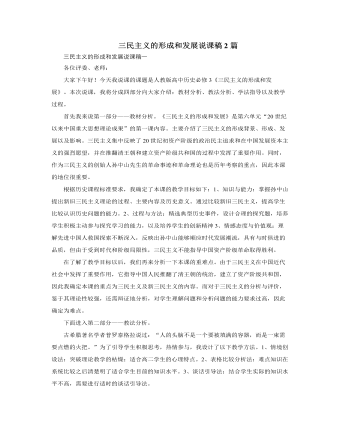
人教版高中历史必修3三民主义的形成和发展说课稿2篇
在学生正确掌握了三民主义的进步性和局限性之后,提出第五个问题:三民主义的局限性是由什么决定的?这一问题学生较易回答,为进入下一目教学打下基础。二、三民主义的实践这目内容在新课导入时已经涉及,故进行略讲,主要采用谈话法,与学生一起回忆、交流。在此基础上,提出探究问题五:在三民主义指导下,孙中山先生进行的一系列革命斗争其结局怎样?为什么会这样?第一问学生较易回答,第二问我组织学生进行交流、讨论。在学生回答的基础上,我将向学生指出:由于三民主义的局限性,它不能指导中国民主革命走向成功,中国革命呼唤新的理论指导。从而过渡到下一目教学。三、旧三民主义发展为新三民主义1、背景:情境再现,激发兴趣分析资料,感悟新知多媒体播放电影《孙中山》片段让学生感受在一系列革命斗争失败后,孙中山先生的彷徨、思索。
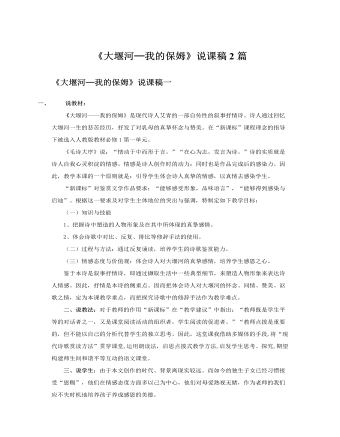
人教版高中语文必修1《大堰河─我的保姆》说课稿2篇
现代诗歌赏读方法四:美读(饱含讴歌与赞美情感再一次有感情地配乐朗读全文,对比前面的朗读,在读中加深情感的领悟。)(五)延伸拓展引进生活的源头活水,用情感来撞开学生的心扉。引导学生找到文章与现实的联系点,抓住这一联系点,让语文回归生活。我设计了“本诗哪些语段让你联想到自己的母亲?讲讲你和母亲的故事。”这个问题是把对大堰河的感情升华为对母亲的感情的过程。这样将语文学习的外延与生活的外延相等,把课文与生活有机地结合在一起。要求学生讲述条理清楚,语言生动。教师可以播放背景音乐,调动学生情感。这样,不仅锻炼了学生的口语表达能力,培养了学生感恩美德,同时也深化了本文的教学难点。现代诗歌赏读方法五:比读(投影出示孟郊《游子吟》比较两诗的异同,并有感情地朗诵。)(六)布置作业。把“你与母亲的故事”整理成一篇文章。
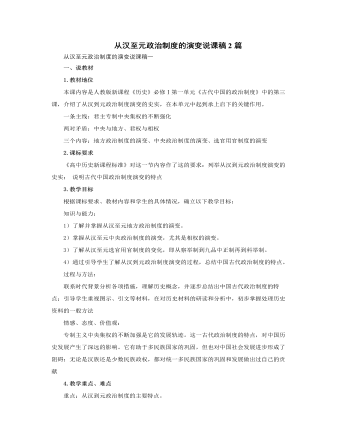
人教版高中历史必修1从汉至元政治制度的演变说课稿2篇
二、君主专制的演进(即中央政治制度的演变)通过地方政治制度演变的学习,掌握方法以后,以学生归纳整理基本线索为主,教师适当点拨,注意纠错。1. 汉承秦制,又有所变化。教师点拨强调继承与发展两个方面。创设情景:同学们看了电视连续剧《汉武大帝》后,知道汉武帝刘彻在继位之后,就急于对西汉王朝的政治制度进行改革。那么,西汉初期中央政治制度的基本框架是怎样的呢?汉武帝为什么要对它进行改革呢?改革后的西汉中央集权制度又是怎样的呢?请大家议一议,想一想。主干知识:西汉初期的中央政治制度的最大特点是“汉承秦制”。具体表现在两个方面:一是继续实行皇帝制度,维护皇权,这一做法也为后来各王朝所沿用;二是在中央设立三公,分别掌管行政、监察和军事。到汉武帝时,“中朝”成为西汉重要的中央决策机构,尚书令的权力日益重要,以丞相为首的三公九卿的权力被削弱,演化为执行机构。到了东汉光武帝时,进一步剥夺三公权限,扩大尚书的权力。
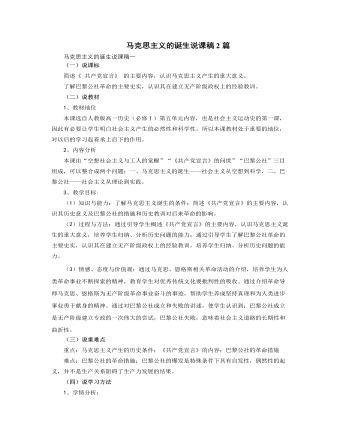
人教版高中历史必修1马克思主义的诞生说课稿2篇
3、马克思主义的三大思想来源之一——空想社会主义理论,教师可以采用多媒体技术、投放幻灯片、人物图片等资料进行处理。这样既能增强课堂的趣味性,激发学生的兴趣,也容易让学生理解什么是“空想社会主义”。可以分别投放圣西门的实业制度、傅立叶的“法朗吉”和欧文的“新和谐公社”等资料加深学生的理解。为了充分发挥学生的学习主体性地位,还可以利用教材中“学习思考”的问题设计:为什么说圣西门等思想家提出的设想是空想的?让学生在教师提供的材料中探究答案。至于马克思主义的另两大思想来源:德意志古典哲学、英国古典政治经济学可以简单处理。而马克思、恩格斯为无产阶级革命事业奋斗的事迹以及马恩两人的友谊是可以稍加扩长的部分,教师可事先布置学生任务,让学生通过网络或者书籍去查找相关知识,也或者由教师在课堂上补充相关资料,调节课堂气氛。
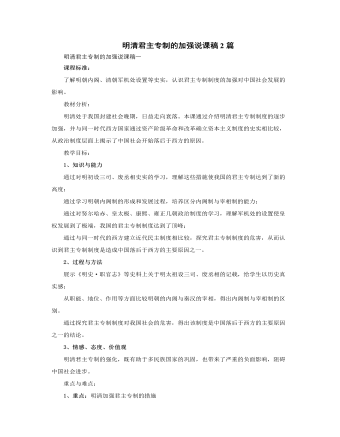
人教版高中历史必修1明清君主专制的加强说课稿2篇
四、说教法应该充分利用历史学科蕴含丰富图片、史料资料的特点,采用多媒体教学手段,创设含有真实事件或真实问题的情境,让学生在探究事件或解决问题的过程中,自主地理解知识,使教学过程成为一个动态的、有机的整体。使学习过程成为“感知-理解-运用”的过程,更是掌握方法、积累经验、发展能力、生成情感的过程。五、说教学过程1.新课导入带领同学们回顾一下第2、3课学习的内容,因为讲的是专制主义中央集权的建立,讲的是专制主义中央集权的发展,对这两节课内容的复习将专制主义中央集权的发发展脉络完整的呈现在学生面前。接下来就通过对胡惟庸案的讲解导入本节课的内容。2.问题探究,突破重点、难点导入新课后,通过多媒体课件给学生们展示一段朱元璋大肆杀戮功臣的资料,提示学生大肆杀戮功臣是朱元璋加强中央集权的措施之一,接着引导学生看课本提问他们朱元璋为了加强中央集权还采取了哪些措施,从而得出明代加强中央集权的措施。
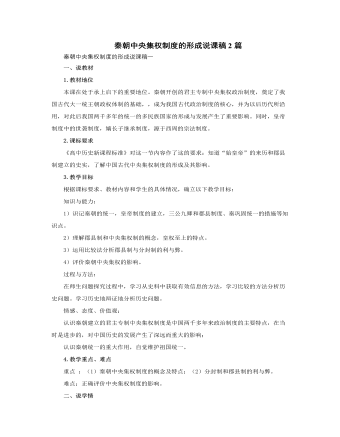
人教版高中历史必修1秦朝中央集权制度的形成说课稿2篇
问题设计:通过这一课的学习,同学们能解释君主专制中央集权制度的含义吗?【总结】封建专制主义中央集权制度包括专制主义和中央集权制两个概念。专制主义是就中央的决策方式而言的,主要体现在皇位终身制和世袭制上,特征是皇帝个人独裁专断,集国家最高权力于一身,从决策到行使军政财权都具有独断性和随意性;中央集权则是相对于地方分权而言,其特点是地方政府在政治、经济、军事等方面没有独立性,必须充分执行中央的政令,一切服从于中央。三、秦朝中央集权制的影响展示图片:《秦朝疆域图》正是由于有一个统一集中的中央政权,秦王朝才能积极开拓疆域,北拒匈奴,南吞百越,有利于我国多民族国家统一发展。为了巩固统一的国家,秦朝还通过实行哪些措施巩固统一局面?展示图片:“秦半两钱”“秦权”“小篆”“秦简”等图片。正是有一个强有力中央政府,才统一了货币、文字、度量衡,才开驿道、修灵渠,从而促进了中国经济文化的发展进步。展示“孟姜女哭长城”的故事材料从故事及你所掌握的材料中,你认为秦朝能否长治久安?为什么?
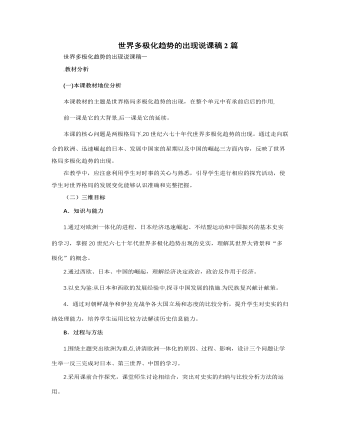
人教版高中历史必修1世界多极化趋势的出现说课稿2篇
(一)本课教材地位分析本课教材的主题是世界格局多极化趋势的出现,在整个单元中有承前启后的作用,前一课是它的大背景,后一课是它的延续。本课的核心问题是两极格局下,20世纪六七十年代世界多极化趋势的出现。通过走向联合的欧洲、迅速崛起的日本、发展中国家的星期以及中国的崛起三方面内容,反映了世界格局多极化趋势的出现。在教学中,应注意利用学生对时事的关心与熟悉,引导学生进行相应的探究活动,使学生对世界格局的发展变化能够认识准确和完整把握。(二)三维目标A.知识与能力1.通过对欧洲一体化的进程、日本经济迅速崛起、不结盟运动和中国振兴的基本史实的学习,掌握20世纪六七十年代世界多极化趋势出现的史实,理解其世界大背景和“多极化”的概念。2.通过西欧、日本、中国的崛起,理解经济决定政治,政治反作用于经济。

人教版高中政治必修3博大精深的中华文化说课稿2篇
板书:多民族文化对中华文化的意义师:中华民族是多民族的共同体,中华文化呈现多种民族文化的丰富色彩。中华各民族的文化,既有中华文化的共性,又有各自的民族特性。它们都是中华文化的瑰宝,都是中华民族的骄傲。各兄弟民族文化相互交融、相互促进,共同创造了中华文化。各族人民对共同拥有的中华文化的认同感和归属感,显示了中华民族厚重的文化底蕴和强大的民族凝聚力。问题探究8温家宝总理在美国会见华侨时满怀深情地说,中国已解决了香港问题和澳门问题,洗刷了百年耻辱,现在剩下一个台湾问题,“这一湾浅浅的海峡是我们最大的乡愁、最大的国殇”。用有关知识分析:为什么“这一湾浅浅的海峡是我们最大的乡愁、最大的国殇”?生1:台湾是中国的一部分,台湾各族人民是中华民族的一部分,台湾文化归属于中华文化。生2:传统的民族文化是维系民族生存和发展的精神纽带。

人教版高中历史必修3建国以来的重大科技成就说课稿2篇
说教材(一)、本课在教材中的地位:教材在第3单元介绍了古代中国科技的辉煌。第四单元介绍世界近代科技成就,本课主要介绍了现代中国的科技成就。通过对本课的学习,有利于学生感受中国科技古代辉煌、近代落后、现代又取得很大成就这一重要历程,因此本课在教材中具有重要作用。(二)教学内容分析和课标要求:本课主要介绍新中国成立以来我国科学技术成就及作用。从核研究、航空技术、农业新品种研究、计算机应用、生物技术五方面介绍了新中国成立以来取得的举世瞩目的成就。课标对这部分知识作了如下的要求:列举新中国成立以来科技发展的主要成绩,认识科技进步在现代化建设中的重大作用。根据以上对教材内容的分析和课标要求,我将本课的三维目标确定如下:(三)、教学目标1、知识与能力:识记建国后六十多年来所取得的科技成就;理解科学技术是生产力的论断;探究科技的发展在现代化建设中的重要作用。

人教版高中语文必修3《马嵬(其二)》教案2篇
结合历史自古以来,江山美人历来都是引无数英雄豪杰竞折腰的,如果说英雄选择了美人却丢了江山,把所有罪名都归结于“女人是祸水”。但是,纣王无道,和有了妲己有必然的联系吗?有人说妲己坏透了,坏透了的妲己如果不是取得纣王的信任是坏不起来的,纣王听信了妲己的谗言,听与不听决定权在纣王,而不在妲己。强势永远在纣王一边。再来看看西施和杨贵妃:西施是作为越国贡献给吴国的供品来到吴王夫差的身边的,杨贵妃更是先是李隆基的儿媳妇被看中而得宠的。所以,西施和杨贵妃这两个可怜的女人根本没有自己的独立选择,没有独立的爱情,如果没有西施,就会有南施,或北施;如果没有杨贵妃,就会有李贵妃,王贵妃,总之什么施,什么妃是不能少的,因为那是吴王和李隆基的需要。
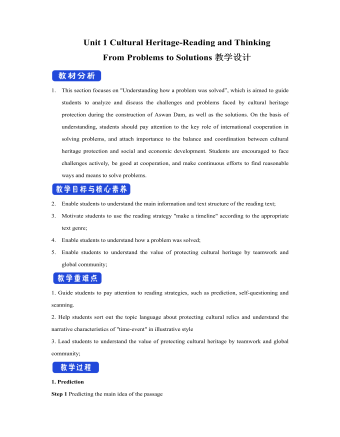
新人教版高中英语必修2Unit 1 Cultural Heritage-Reading and Thinking教案二
1. This section focuses on "Understanding how a problem was solved”, which is aimed to guide students to analyze and discuss the challenges and problems faced by cultural heritage protection during the construction of Aswan Dam, as well as the solutions. On the basis of understanding, students should pay attention to the key role of international cooperation in solving problems, and attach importance to the balance and coordination between cultural heritage protection and social and economic development. Students are encouraged to face challenges actively, be good at cooperation, and make continuous efforts to find reasonable ways and means to solve problems.2. Enable students to understand the main information and text structure of the reading text;3. Motivate students to use the reading strategy "make a timeline" according to the appropriate text genre;4. Enable students to understand how a problem was solved;5. Enable students to understand the value of protecting cultural heritage by teamwork and global community;1. Guide students to pay attention to reading strategies, such as prediction, self-questioning and scanning.2. Help students sort out the topic language about protecting cultural relics and understand the narrative characteristics of "time-event" in illustrative style3. Lead students to understand the value of protecting cultural heritage by teamwork and global community;

